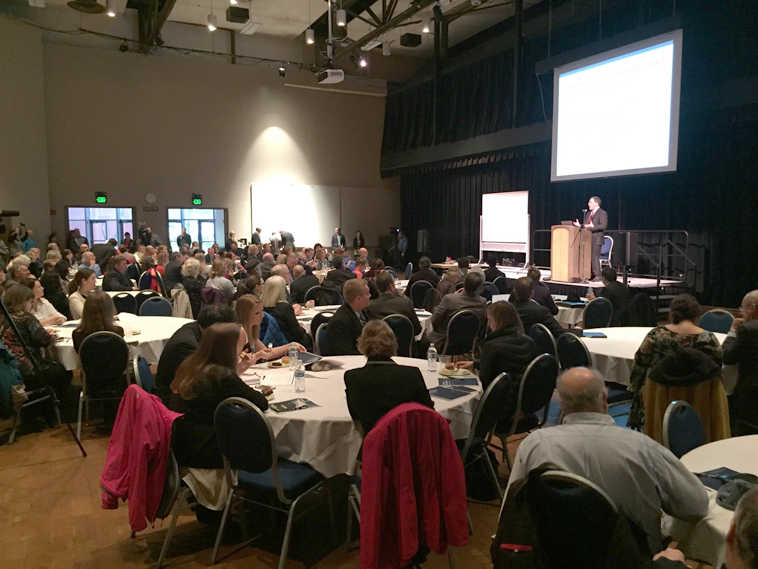Gov. Bill Walker’s administration is preparing to roll out the most radical change to the state’s annual budgeting process since the creation of the Alaska Permanent Fund in 1976.
At noon Wednesday in Centennial Hall, lawmakers were briefed on a budget plan that redirects almost all of the state’s oil revenue to the Permanent Fund, in effect turning it into a money factory that would generate about $3.3 billion per year.
The plan also promises to radically change the way the annual Permanent Fund Dividend is paid.
“It is now clear that, barring a change in the economic environment, that our financial wealth assets will generate substantially more income than petroleum revenues in the future,” said attorney general Craig Richards on Wednesday morning.
The details of the proposal are complicated, but in broad outline, it isn’t dissimilar to the system of reservoirs that feed Juneau’s drinking water and hydroelectric power needs.
Under the proposal, most of Alaska’s oil and gas revenue would flow directly into the Permanent Fund. A portion of the fund’s annual growth — which now comes more from investments than oil — would go to the fund’s earnings reserve, a separate reservoir.
That reservoir already exists, and it can be accessed by a simple majority vote of the Alaska Legislature — but it’s rarely touched because most Alaskans consider the reserve part of the Permanent Fund proper.
Under the proposal, there would be an annual transfer of about $3.3 billion from the reserve to the state’s general fund, which pays for state services.
If the stock market drops — as it did during the Great Recession — and the Permanent Fund loses money as it did in 2008 (it lost 18 percent of its value), the earnings reserve acts as a buffer and allows the state to keep collecting $3.3 billion a year.
If the Permanent Fund averages 6.7 percent growth — according to the fund’s latest annual report, it has averaged less, 6.4 percent, over the past 10 years — the arrangement could be kept up forever, Richards said.
The key idea, Richards said, is to iron out the up-and-down swings of oil prices and give the state a steady source of income. That would reduce the explosion of government growth during fat oil years and reduce the need for cuts when times are tough.
“What are you doing if you’re jerking your economy around like a see-saw?” he asked. “I believe, and I think others will once they begin to think about it, is that this is a powerful idea for the Alaska economy itself.”
As for the Permanent Fund Dividend, the plan would tie Alaskans’ annual checks directly to oil and gas revenue, instead of to investment income.
Currently, dividends are based on a five-year average of the fund’s performance, not of oil prices. That’s why this year’s dividend was among the highest on record (once adjusted for inflation), even though oil prices have plummeted.
According to a flow chart provided by the governor’s office, dividends would be paid by half the oil and gas royalties collected by the state each year.
“We’re changing the nature of how the dividend is calculated — we’re proposing a change — to how the dividend is calculated, and we’re going from one that is based on stock market returns to one that is based on oil royalty returns,” Richards said.
He said Alaskans could expect dividends to be about $1,000 per year under that scenario and current production figures.
“But if we get a gasline, if SB21 works and we get a rise in oil production, or if commodity prices turn around and you get an increase, well, the royalty dividend payout will be higher,” Richards said.
“If production is lower and prices are low, and you don’t get a gas pipeline, then royalty payments will be lower,” Richards said.
If the trans-Alaska oil pipeline shuts down and there’s still no gas pipeline — Richards said he doesn’t think that scenario is likely — the dividend would all but disappear.
The proposal won’t completely fill the state’s gap between revenue and expenses. According to an analysis provided by the state, the Permanent Fund would have to have “well over $100 billion to generate sufficient revenues to fully fund the state budget and allow for dividends at the current rate.”
Grace Jang, a spokeswoman for Gov. Walker, said it’s important to remember that using the Permanent Fund “is the major underpinning of the plan” to balance the state budget.
“We’re not saying this is the plan,” she said.
Either more cuts or additional revenue — such as a sales tax or income tax — would still be needed to balance the budget without using savings.

